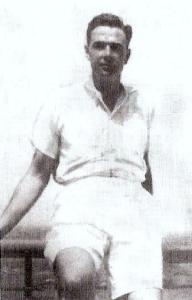
|

|
| Chaplain the Reverend William BONSEY RNVR | |
|
HMS Gloucester, Royal Navy Date of birth: 17th February 1912 Date of death: 22nd May 1941 Killed in action aged 29 Commemorated on the Plymouth Naval Memorial Panel 61 Column 3 |

|
| William Bonsey was born at The Rectory at Morecombe on the 17th of February 1912 the son of the Reverend William Henry Bonsey MA, Rector of Groton, and Ernestine Colville Leramouth (nee Gilchrist) Bonsey of Groton in Suffolk. He was educated at Belmont School, Clayton and at Lancing College where he was in Sandersons House from September 1925 to July 1930. He went on to St John's College Cambridge in 1930 where he read Divinity and achieved a BA in 1933. His tutor there was E.A. Benians. He went on to Ely Theological College and was made a Deacon in 1935 and was ordained as a Priest by the Bishop of Winchester in 1936. He was Curate of Weeke in Hampshire from 1935 to 1937 when he became Curate of Moordown until 1939. On the 28th of December 1939 he was appointed as a Chaplain in the Royal Naval Volunteer Reserve and in the summer of 1940 he replaced the Reverend Payton as Chaplain to the light cruiser HMS Gloucester. On the 22nd of May 1941 HMS Gloucester, under the command of Captain Henry Aubrey Rowley RN, was 14 miles to the north of Crete in the Kythira Channel as part of a force attacking German military transports in the area. At 6.30am she was spotted by a force of Junkers 87s Stuka aircraft that attacked her for about an hour causing her to expend a large volume of ammunition although she came through the attack virtually unscathed. At 2.07pm, despite being very low on anti aircraft ammunition and low on fuel, she was sent with HMS Fiji to provide anti aircraft support to HMS Kandahar and HMS Kingston who were picking up survivors from HMS Greyhound which had been sunk. By 2.30pm her ammunition was so low that she was given permission to withdraw and join the main force. While returning, at about 3pm, she came under attack from a number of Junkers 88 and 87 aircraft who hit her with four bombs and three near misses. At 3.45pm there were three violet explosions, causing the crew to begin to abandon ship. During this period William Bonsey, along with Leading Sick Berth Attendant Brian Stavert Priestly, was assisting New Zealander, Junior Surgeon Hugh Singer in attending to the wounded. They stayed until the last moment, assisting the wounded into the water and abandoned ship at around 5.15pm by which time the port gunwales were awash and they simply stepped into the sea. Singer swam to join a large group of survivors, which included Bonsey. They were clustered around two of the ship's fenders which had been bound together with wire rope. It was from this position that they saw the ship sink at 5.30pm. Lieutenant Singer decided to swim for the island of Kythira to get help but soon realised that it was in fact some 15 miles away and returned. Soon after Singer's return, William Bonsey decided to set out for the island himself, in spite of the pleas of his fellows not to. He was not seen again. Singer survived along with 84 others but Priestley and Bonsey were lost along with 721 of their fellow crew members. He is commemorated on the Groton War Memorial and on a plaque at St Bartholomew's Church there. He is also commemorated on the memorial at St John’s College Cambridge. |
|
| Sandersons House |
Back